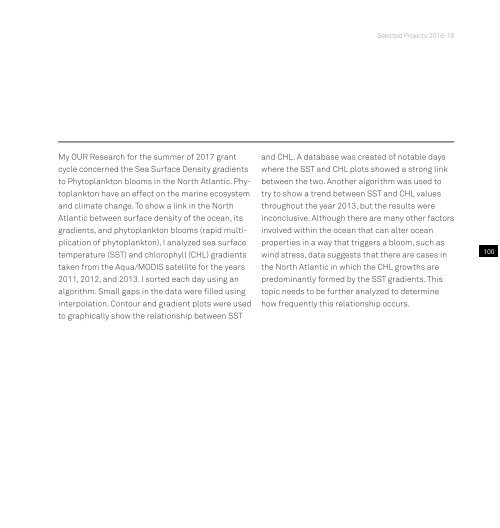Undergrad_Book_16-18_Pge_View_Print_no print marks_compressed
Create successful ePaper yourself
Turn your PDF publications into a flip-book with our unique Google optimized e-Paper software.
Selected Projects 20<strong>16</strong>-<strong>18</strong><br />
My OUR Research for the summer of 2017 grant<br />
cycle concerned the Sea Surface Density gradients<br />
to Phytoplankton blooms in the North Atlantic. Phytoplankton<br />
have an effect on the marine ecosystem<br />
and climate change. To show a link in the North<br />
Atlantic between surface density of the ocean, its<br />
gradients, and phytoplankton blooms (rapid multiplication<br />
of phytoplankton), I analyzed sea surface<br />
temperature (SST) and chlorophyll (CHL) gradients<br />
taken from the Aqua/MODIS satellite for the years<br />
2011, 2012, and 2013. I sorted each day using an<br />
algorithm. Small gaps in the data were filled using<br />
interpolation. Contour and gradient plots were used<br />
to graphically show the relationship between SST<br />
and CHL. A database was created of <strong>no</strong>table days<br />
where the SST and CHL plots showed a strong link<br />
between the two. A<strong>no</strong>ther algorithm was used to<br />
try to show a trend between SST and CHL values<br />
throughout the year 2013, but the results were<br />
inconclusive. Although there are many other factors<br />
involved within the ocean that can alter ocean<br />
properties in a way that triggers a bloom, such as<br />
wind stress, data suggests that there are cases in<br />
the North Atlantic in which the CHL growths are<br />
predominantly formed by the SST gradients. This<br />
topic needs to be further analyzed to determine<br />
how frequently this relationship occurs.<br />
100



